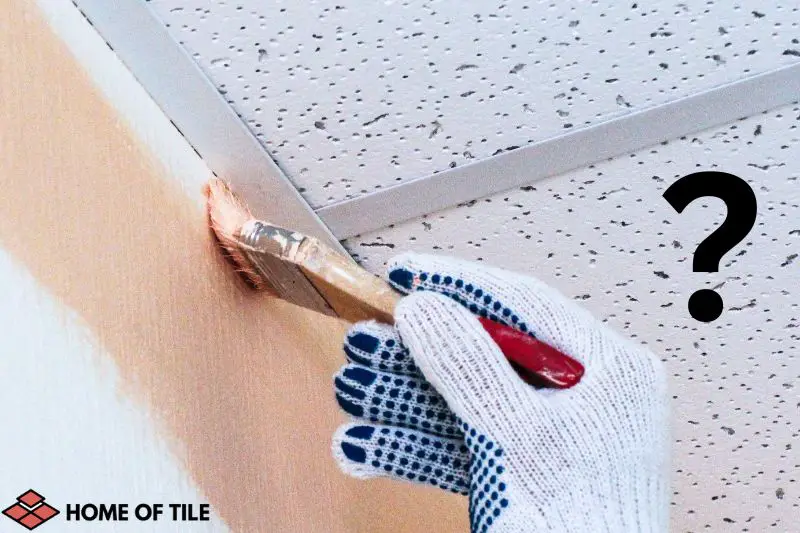Can You Paint Old Ceiling Tiles, 7 Things You Should Know
Over time ceiling tiles can become stained and discolored. Freshening them up is always an option. However, how is this done? And is it possible to paint over the ceiling tiles?

Contents
Can You Paint Old Ceiling Tiles?
Painting old ceiling tiles is a viable choice. It provides a fresh look to the ceiling and the room. The paint can be a flat or satin finish. However, prepping and priming are requirements before painting can start. Another possible requirement is the removal of the tiles before painting.
Replacing the tiles is more expensive. However, clean the ceiling tiles properly before painting. Be on the lookout for stains from water leaks or moisture absorption. The reason being these will impact the final look of the paint job.
It is important to remove each ceiling tile before painting. Removal of the tiles helps with the cleaning process. If the tiles are tin, cleaning involves wiping them with a damp cloth and allowing them to dry thoroughly. Acoustic tiles need a duster for cobwebs or dust removal.
The type of paint available for painting ceiling tiles depends on the materials of the tiles. Certain paint types will cause damage to specific ceiling tiles. Ceiling paint is preferred over interior paint because it is thicker.
Are Foam Ceiling Tiles Paintable?
Foam ceiling tiles are paintable. You should use water-based paint because of its effectiveness on this type of tile. Oil-based paints, even those in spray form, can damage the tiles.
Painting of foam ceiling tiles should occur before installation of the tiles. This process will reduce the possibility of the tiles warping during installation. Also, remove the tiles from the ceiling before painting if touching up is required.
Are Asbestos Ceiling Tiles Easy To Paint Over?
It is easy to paint over asbestos ceiling tiles. It makes it easier to clean and maintain them. Also, the paint holds the seal on the asbestos tiles. It covers any cracks and safeguards the ceiling tiles from falling apart.
Oil-based paint is the paint to use when dealing with asbestos. The reason is that this paint helps with bonding the material together. Also, the reduction of wear and tear is enhanced, prolonging the life of the ceiling tiles.
Painting asbestos is recommended as the paint protects you from the harmful effects of asbestos. However, be careful when painting to ensure you don’t breathe in debris from these tiles.
Painting Fiberboard Ceiling Tiles
There is nothing wrong with painting fiberboard ceiling tiles. Nevertheless, previous painting of the ceiling tiles or if they were unpainted plays a meaningful role in how to complete the painting job.
What paint to use and how to apply it depends on the condition of the fiberboard ceiling tiles. Previously painted tiles should have interior paint that matches the current color on the tiles. Mix-matched paints could lead to either paint bubbling, peeling, or not clinging to the surface.
A lacquer primer or sealer is a necessity for tiles damaged from leaks. This statement is true for both painted and unpainted fiberboard ceiling tiles. It prevents bleed-through from leaks and new paint. In addition, both applications ought to have more than one coat of paint.
The Right Paint for Polystyrene Ceiling Tiles
Emulsion paint is the paint for polystyrene ceiling tiles. It can be rolled, sprayed, or brushed on, but the tiles should be clean. Before installation, tiles with chamfered edges should be painted.
Gloss, solvent-based, or spray-can paints for polystyrene tiles is not the best choice. Solvent-based and spray-can paints damage the tiles to the point of the tiles dissolving. Furthermore, gloss paint acts as a catalyst for fire hazards.
Are Suspended Ceiling Tiles Paintable?
Suspended tiles are paintable. However, the tiles might absorb water-based paints. On the other hand, oil-based paints are a fire hazard, which goes against industry standards.
Furthermore, remove the tiles and allow them to dry thoroughly before replacing them in the grid. Painting the tiles without removing them first could lead to them clinging to the grid, defeating the initial reasons for installing suspended tiles.
How To Paint Old Ceiling Tiles
Each type of ceiling tile will have guidelines about the type of paint and if the tiles need removal. However, prepping and priming before painting is necessary regardless of the ceiling tile. They must follow these four P’s below.
- Protect Work Area: Whether you remove the tiles or not, cover the area with an old cloth, plastic, or paper. Paint can drip unto the floor or furniture when painting them in place. Dust, damaged tiles, dead insects, or debris can fall from the ceiling unto the floor or furniture.
- Prepping: Prepping the tiles can include cleaning, sanding, or repairing. After prepping, allow the tiles to dry or seal for an adequate amount of time, at least a few hours, before painting. Prepping also involves wearing gloves, masks, goggles, and other protection.
- Priming – Use a lacquer, shellac-based, or stain-sealing primer to coat the tiles before painting. The primer to use will depend on the material of the tiles. In some cases, more than one coat is required, especially for tiles that absorb the primer. Allow tiles to dry thoroughly.
- Painting: Similar to priming, the paint to use will depend on the material of the tiles. In addition, extra sanding between layers is possible, specifically when using shellac-based primers. Apply a second coat of paint after allowing the first coat to dry completely. Pay close attention to areas with stains, as these may bleed through coats and need extra paint.
Before priming and painting, ensure that the work area is fully ventilated. Open windows, and place fans in the openings to extract the fumes from the work area if you can’t work outside. Try to avoid breathing in the fumes for too long. Inhaling fumes for primer or paint can be very dangerous.
At each stage of the process, allow the tiles to dry completely before moving to the next step.







